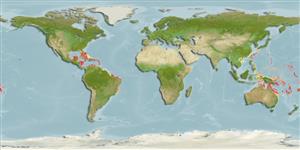Agelas clathrodes (Schmidt, 1870)
Orange elephant ear sponge| Native range | All suitable habitat | Point map | Year 2050 |

|
| This map was computer-generated and has not yet been reviewed. |
| Agelas clathrodes AquaMaps Data sources: GBIF OBIS |
Upload your photos
Google image |
No photo available for this species.No drawings available for Agelasidae.
Google image |
No photo available for this species.
Classification / Names Common names | Synonyms | CoL | ITIS | WoRMS
Demospongiae | Agelasida | Agelasidae
Environment: milieu / climate zone / depth range / distribution range Ecology
Sessile; depth range 2 - 61 m (Ref. 108813). Tropical
Distribution Countries | FAO areas | Ecosystems | Occurrences | Introductions
Western Atlantic and Western Central Pacific.
Length at first maturity / Size / Weight / Age
Maturity: Lm ? range ? - ? cm Max length : 10.0 cm OT male/unsexed; (Ref. 415)
Short description Morphology
Massive; flabellate; rising from a narrow base: 1.5 - 10 cm thick. Bright red-orange externally, lighter internally. The margin is rounded, or indented. Compressible, resilient. The surface is rough to be touch to verrucose, with abundant membrane-bearing oscula: 0.2 - 0.5 cm in diameter (Ref. 415). Color range from orange to brown (Ref. 81728).
Maximum thickness: 10 cm (Ref. 415). Maximum depth reported taken from Ref. 128739. Found in coral reefs, usually below 10 m in depth (Ref. 415), and on rocky bottoms (Ref. 83912). It hosts alpheid shrimps, i.e., Synalpheus spp. in its canals (Ref. 86672). Inhabits shallow and mesophotic coral reefs along with coral communities and coralline algae reefs (Ref. 128739).
Life cycle and mating behavior Maturity | Reproduction | Spawning | Eggs | Fecundity | Larvae
Members of the class Demospongiae are hermaphroditic. Life cycle: The zygote develops into parenchymella larva (free-swimming) before settling down on a substrate where it grows into a young sponge.
Main reference
References | Coordinator | Collaborators
Collin, R., M.C. Díaz, J. Norenburg, R.M. Rocha, J.A. Sánchez, M. Schulze, A. Schwartz and A. Valdés. 2005. (Ref. 415)
IUCN Red List Status (Ref. 130435)
CITES status (Ref. 108899)
Not Evaluated
CMS (Ref. 116361)
Not Evaluated
Threat to humans
Harmless
Human uses
| FishSource |
Tools
More information
Internet sources
BHL | BOLD Systems | CISTI | DiscoverLife | FAO(Publication : search) | Fishipedia | GenBank (genome, nucleotide) | GloBI | Gomexsi | Google Books | Google Scholar | Google | PubMed | Tree of Life | Wikipedia (Go, Search) | Zoological Record
Estimates based on models
Preferred temperature
(Ref. 115969): 26 - 28.3, mean 27.2 (based on 435 cells).
Price category
(Ref. 80766):
Unknown.


